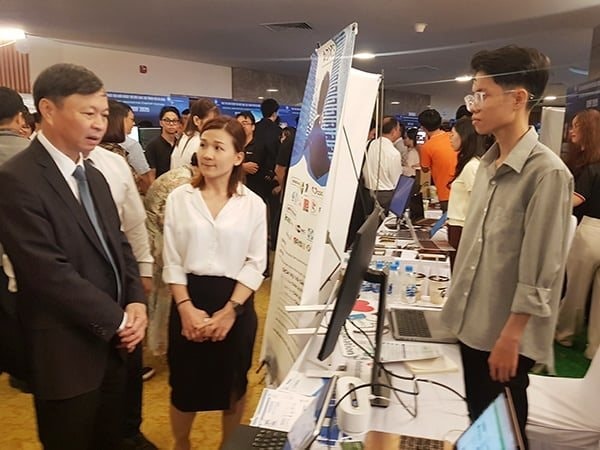NATIF allocates 40% budget to AI: A turning point in technology support policy
Minister of Science and Technology Nguyen Manh Hung has emphasized that the National Technology Innovation Fund (NATIF) will dedicate at least 40% of its budget to support AI.
A turning point in AI support policy
The statement by Minister Nguyen Manh Hung at the national scientific workshop: "The Unlimited Power and Unforeseeable Challenges of Artificial Intelligence (AI) - Impacts and Policy Responses" is not merely information on budget allocation, but an affirmation of the state's strategic vision for AI.
For many years, AI research and applications in Vietnam have primarily been within the scope of institutes, schools, or small-scale trials at some large enterprises. There has not yet been a strong enough ecosystem for AI to become a pervasive tool in production and management.

The decision to assign NATIF to allocate 40% of its budget to AI demonstrates a shift in management thinking: From viewing AI as an experimental field, it is now placed on par with previously prioritized sectors like biotechnology or clean energy. This means AI is recognized as a technological-economic-social infrastructure that requires long-term investment, similar to electricity, telecommunications, or the Internet.
The policy highlight lies in its role as "seed capital." The 40% budget allocation is not only direct support for projects but also aims to encourage private enterprises and venture investors to participate.
If implemented through vouchers or co-funding mechanisms, even small and medium-sized enterprises (SMEs) - which have difficulty accessing traditional credit sources - will have opportunities to access AI. When capital barriers are removed, bold ideas will have the conditions to enter practice, thereby paving the way for a generation of "Make in Viet Nam" AI products.
In particular, this policy also aims to address previous gaps: Although Vietnam has had a National AI Strategy until 2030, its implementation has been fragmented, lacking a strong enough financial mechanism to concentrate resources. With NATIF as the focal point, AI projects with high commercialization potential or serving urgent needs such as healthcare, education, and smart agriculture will be prioritized, instead of being spread thin.
Budget foundation and investment efficiency
To clearly see the feasibility of this commitment, it is necessary to look at NATIF's financial foundation and operational performance. The fund was established under Decision 1342/QD-TTg in 2011, initially with a charter capital of 1,000 billion VND, which doubled to 2,000 billion VND by 2021. Along with that is a socialization mobilization mechanism, allowing the fund not to be entirely dependent on the state budget.
In the 2015-2020 period, NATIF received over 1,000 proposals, mobilizing about 782 billion VND in matching capital. The funded enterprises increased revenue by about 4,000 billion VND/year, achieved pre-tax profits of 800 billion VND, contributed 300 billion VND to the budget, and commercialized nearly 50 technologies and equipment in fields such as agriculture, pharmaceuticals, and mechanics. These figures show that NATIF has operated effectively, creating clear leverage for innovation.
However, AI is a field with distinct characteristics: high research and testing costs, complex legal risks, and long payback periods. Therefore, to make the capital truly effective, NATIF needs to adjust evaluation criteria, particularly emphasizing: data infrastructure capacity, product scalability, and social impact.
With a stable capital foundation and successful support experience in many fields, NATIF can fully become the "financial infrastructure" for AI, as long as the selection and monitoring mechanisms are transparent.
Prospects and quantitative requirements for AI
According to Minister Nguyen Manh Hung, AI support capital must be tied to specific and measurable indicators. Criteria to consider include: the rate of commercialized projects, revenue growth levels, number of new patents and applications, as well as job creation potential. Only when capital is linked to quantifiable results can the policy prove its real effectiveness.
A noteworthy new point in the Minister's statement is the voucher issuance mechanism for SMEs. Instead of just funding research, the capital will directly support the costs of implementing AI solutions, shortening the path from laboratory to market.

Following the direction of Minister Nguyen Manh Hung, Mr. Bui Quang Minh, Director of the National Technology Innovation Fund, stated that the Fund has developed a draft and will submit for issuance a "voucher" mechanism to support small and medium-sized enterprises in accessing "Make in Viet Nam" AI solutions. The entire implementation process will adhere to the spirit of the Law on Science, Technology, and Innovation, ensuring transparency, efficiency, and most importantly, providing maximum favorable conditions for enterprises.
"Our goal is not just to disburse capital but to turn NATIF into a strategic financial tool to support the national AI ecosystem," said Mr. Bui Quang Minh.
The Minister also cited international experiences as lessons from Israel, the EU, and Korea. Israel links funding with co-financing mechanisms and profit sharing; the EU requires transparency in data management and compliance with AI ethics; Korea combines public capital with tax incentives and human resource training programs. These experiences show that Vietnam needs to design funding mechanisms that are both transparent and encourage matching capital commitments, while ensuring standards on data and technology ethics.
Connecting the ecosystem and affirming NATIF's role
Minister Nguyen Manh Hung emphasized that AI cannot develop sustainably if it only stops at fragmented financial support. NATIF's more important role is to act as the "conductor" connecting the links in the innovation ecosystem.
When preferential capital flows are deployed, the demand for human resource training, data infrastructure development, and research collaboration will increase accordingly, creating a positive vortex that promotes technology diffusion. If NATIF knows how to link financial support with AI engineer training programs, open laboratories, and shared data platforms, the 40% capital allocation will serve as a catalyst to infuse AI into production, services, and management.
The vision outlined by the Minister is not just about providing capital, but about forming standards for public-private cooperation in innovation. When enterprises are assured about capital, research institutes have application partners, and the state maintains its coordinating and supervisory role, the "Make in Viet Nam" AI ecosystem will gradually form, strong enough to compete internationally.
In the context of Vietnam aiming for productivity growth, digital economy development, and enhancing its technological position, NATIF is expected to become the "key financial infrastructure for AI," accompanying enterprises and research institutes, turning AI into a sustainable driving force for the economy./.
